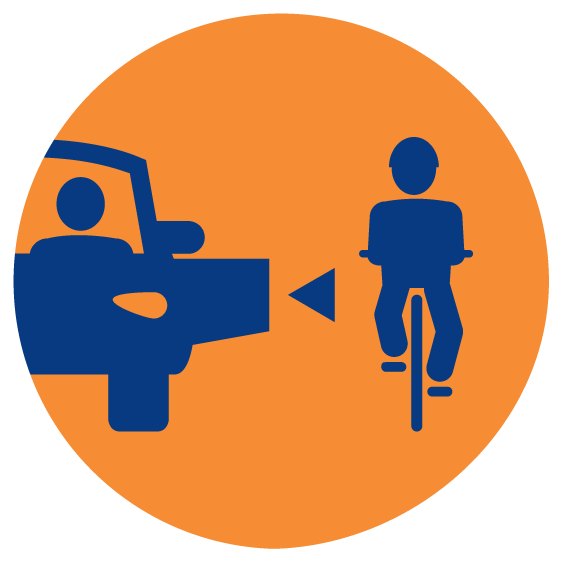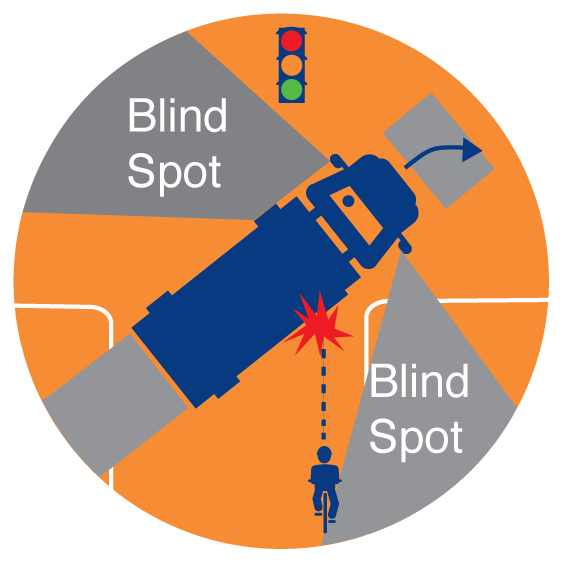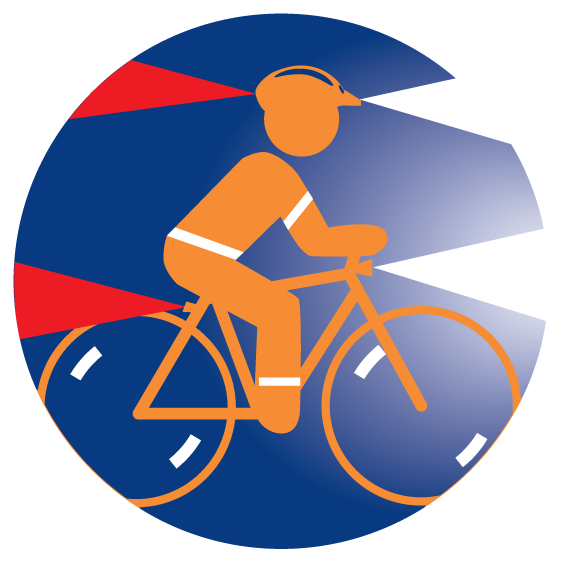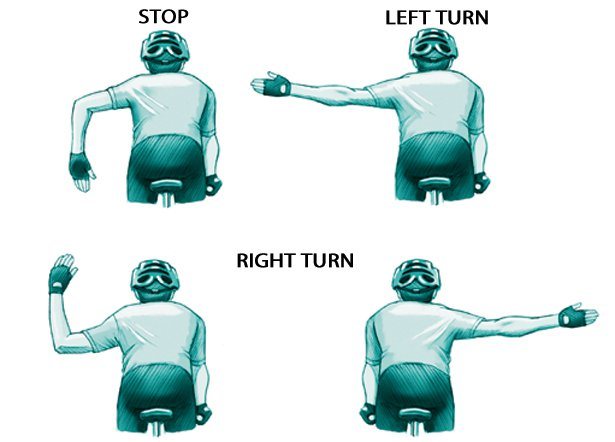Beware of doors. Leave 3 feet.

You are allowed full use of the road, so ride at least 3 feet from parked cars, even in traffic, even if this means you’re at the edge or outside of the bike lane. Do not assume that parked cars are empty, and do not assume that the driver will look before opening the door.
Follow the rules of the road. Yield to pedestrians.
 Bikes are considered vehicles and are expected to follow all rules of the road.
Bikes are considered vehicles and are expected to follow all rules of the road.
Ride in the direction of traffic. Stay off sidewalks in business districts. Stop for all red lights and stop signs. When there are traffic signals, wait for the green light. The walk signal indicates that it is safe for pedestrians to cross the intersection. This signal is not for cyclists. Wait for the green light before proceeding through the intersection. Failure to follow the rules of the road creates dangerous situations for both you and others.
When there are no traffic signals you must yield to pedestrians. They have the right of way. Failing to yield may result in a fine.
Avoid blind spots.
 Trucks, buses, and over-sized vehicles have large blind spots, particularly on the right. Avoid overtaking large vehicles. Stay visible to the drivers – if you can’t see the driver in the mirror, the driver can’t see you. The majority of cyclist fatalities in Boston have involved large vehicles.
Trucks, buses, and over-sized vehicles have large blind spots, particularly on the right. Avoid overtaking large vehicles. Stay visible to the drivers – if you can’t see the driver in the mirror, the driver can’t see you. The majority of cyclist fatalities in Boston have involved large vehicles.
The “right hook” can be extra dangerous. Cyclists can get seriously injured by large vehicles turning and not seeing cyclists. Take extra caution at intersections and avoid being to the right of large vehicles.
Wear a helmet and use lights.
 Wear your helmet. Use lights, reflectors, and bright clothing to see and be seen. Lights are required by law in the time between ½ hour after sunset and ½ hour before sunrise. You must have at least one white light on the front, and one red light on the rear of your bike. You must have reflectors on your your pedals or on your ankles. You may use as many lights and reflectors as you wish.
Wear your helmet. Use lights, reflectors, and bright clothing to see and be seen. Lights are required by law in the time between ½ hour after sunset and ½ hour before sunrise. You must have at least one white light on the front, and one red light on the rear of your bike. You must have reflectors on your your pedals or on your ankles. You may use as many lights and reflectors as you wish.
Helmets are required for anyone 16 or younger. Everyone should wear a properly fitting helmet anytime they ride a bike.
Where to buy a helmet
You can purchase a helmet for $10 (pay by check) from LL-15 in the Kresge Building of the Harvard T.H. Chan School of Public Health or in HMS’ Parking Office at 180B Longwood Ave in room 132. They’re also available for $12 in the gift shop of Dana Farber Cancer Institute and for $10 in room 835 of the Smith Campus Center in Cambridge.
If your lose your helmet or it breaks while you’re at school, the HMS Parking Office (180B Longwood Ave, room 132) also has emergency rental helmets available upon request.
Make sure your helmet is properly fitted.

Helmets are not reusable. If you hit your head with some force while wearing a helmet, even if it doesn’t break, you should buy a new one.
Urban Cycling Guide
Harvard University has partnered with the City of Boston to promote a new Urban Cycling Safety Campaign!
Test your Bike-Q – Earn free gear
Boston loves cyclists, so we want to make sure you’re prepared for everything. Learn how to avoid common urban hazards. Know the rules of the road and proper cycling etiquette, too. Ride smart. Ride safe. And most of all, enjoy yourself.
As part of the campaign be sure to review safety tips, and check out a series of videos to learn about rules of the road and ways to improve your cycling skills.
Signaling 101
One of the best ways to stay safe is by behaving predictably. Following the rules of the road and signaling help cars, pedestrians and other cyclists understand what to expect from you and where you’re going.

Additional safety resources:
- Boston’s Urban Cycling Guide
- Boston Bikes Safety Campaign
- How to not get hit by cars
- Commuting tips
- How to ride your bike on a road with traffic (video)
- The Rights and Duties of Cyclists (video)
- Bike Safe Boston Blog
- Bike Laws and Rights (Mass Bike)
- How to lock your bike (video)
- How big is a truck’s blind spot? (video)
- Winter Riding Tips
Employees interested in learning about bicycle safety or repair techniques can take classes at any location and be reimbursed for expenses. Employees must verify eligibility prior to class registration by emailing commuterchoice@harvard.edu or calling (617) 384-7433.



